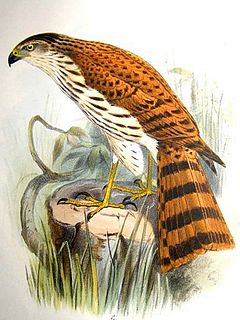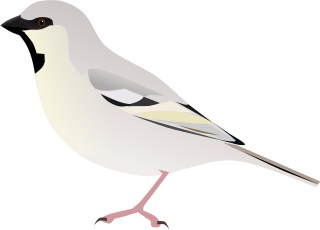
The hammerhead sharks are a group of sharks that form the family Sphyrnidae, so named for the unusual and distinctive structure of their heads, which are flattened and laterally extended into a "hammer" shape called a cephalofoil. Most hammerhead species are placed in the genus Sphyrna, while the winghead shark is placed in its own genus, Eusphyra. Many, but not necessarily mutually exclusive, functions have been postulated for the cephalofoil, including sensory reception, manoeuvering, and prey manipulation. The cephalofoil gives the shark superior binocular vision and depth perception.

The International Union for Conservation of Nature is an international organization working in the field of nature conservation and sustainable use of natural resources. It is involved in data gathering and analysis, research, field projects, advocacy, and education. IUCN's mission is to "influence, encourage and assist societies throughout the world to conserve nature and to ensure that any use of natural resources is equitable and ecologically sustainable".

The International Union for Conservation of Nature (IUCN) Red List of Threatened Species, founded in 1964, is the world's most comprehensive inventory of the global conservation status of biological species. It uses a set of precise criteria to evaluate the extinction risk of thousands of species and subspecies. These criteria are relevant to all species and all regions of the world. With its strong scientific base, the IUCN Red List is recognized as the most authoritative guide to the status of biological diversity. A series of Regional Red Lists are produced by countries or organizations, which assess the risk of extinction to species within a political management unit.

Accipiter is a genus of birds of prey in the family Accipitridae. With 51 recognized species it is the most diverse genus in its family. Most species are called goshawks or sparrowhawks, although almost all New World species are simply known as hawks. They can be anatomically distinguished from their relatives by the lack of a procoracoid foramen. Two small and aberrant species usually placed here do possess a large procoracoid foramen and are also distinct as regards DNA sequence. They may warrant separation in the old genus Hieraspiza.

The pacarana is a rare and slow-moving hystricognath rodent indigenous to South America. Native Tupi people call it the pacarana because it is superficially similar to the paca, a different rodent which is not in the same family. The pacarana has a chunky body and is large for a rodent, weighing up to 15 kg (33 lb) and measuring up to 79 cm (31 in) in length, not including the thick, furry tail.

A species that is extinct in the wild (EW) is one that has been categorized by the International Union for Conservation of Nature as known only by living members kept in captivity or as a naturalized population outside its historic range due to massive habitat loss.

Hyperolius castaneus is a species of frogs in the family Hyperoliidae. It is found in the highlands of western Burundi, Rwanda, and Uganda as well as eastern Democratic Republic of the Congo. Common names of this species include Ahl's reed frog, brown reed frog, and montane reed frog. The status of the putative subspecies Hyperolius castaneus rhodogaster is unclear, and it may actually be a distinct species. Also Hyperolius constellatus, now a distinct species, was formerly recognized as a subspecies of H. castaneus.

The vinous-breasted sparrowhawk is a species of bird of prey in the family Accipitridae. It is endemic to the island of Sulawesi in Indonesia. Its natural habitats are subtropical or tropical moist lowland forest, subtropical or tropical mangrove forest, and subtropical or tropical moist montane forest.

The crimson-bellied parakeet, more commonly known as the crimson-bellied conure in aviculture, is a species of parrot in the family Psittacidae.
Teretrurus rhodogaster is a species of nonvenomous shield tail snake, endemic to the Western Ghats of India. It is known as Wall's shield tail snake, Palni Mountain burrowing snake, or red-bellied shieldtail.

Zarudny's sparrow, also known as the Asian desert sparrow, is a species of bird in the sparrow family Passeridae, which occurs in Uzbekistan, Turkmenistan, and formerly in Iran. This species has historically been classified as a subspecies of the desert sparrow, which is otherwise restricted to Africa. However, the species has a number of differences with the African species, including very similar plumage in adult males and females, which suggests this species is distinct enough to be considered separate, and possibly not most closely related to the African birds. Consequently, Zarudny's sparrow is treated as a separate species by BirdLife International, the IOC World Bird List, and the Handbook of the Birds of the World Alive.
Oreosaurus is a genus of lizards in the family Gymnophthalmidae. The genus is found in South America.
Oreosaurus achlyens is a species of lizard in the family Gymnophthalmidae. It is endemic to Venezuela.
Oreosaurus luctuosus, the lightbulb lizard, is a species of lizard in the family Gymnophthalmidae. It is endemic to Venezuela.
Oreosaurus mcdiarmidi is a species of lizard in the family Gymnophthalmidae. It is endemic to Chimantá Massif in Venezuela. It is named for Roy W. McDiarmid, American herpetologist, "for his contribution to the knowledge of the Pantepui herpetofauna".
Oreosaurus shrevei, known commonly as the luminous lizard or Shreve's lightbulb lizard, is a species of lizard in the family Gymnophthalmidae. The species is endemic to Trinidad and Tobago.

Symphyotrichum nahanniense is a species of flowering plant in the family Asteraceae endemic to Northwest Territories, Canada. Commonly known as Nahanni aster, it is a perennial, herbaceous plant that grows about 7 to 39 centimetres in height. Its flowers have white to pale rose, often becoming rose-violet, ray florets and yellow then reddish disk florets.











